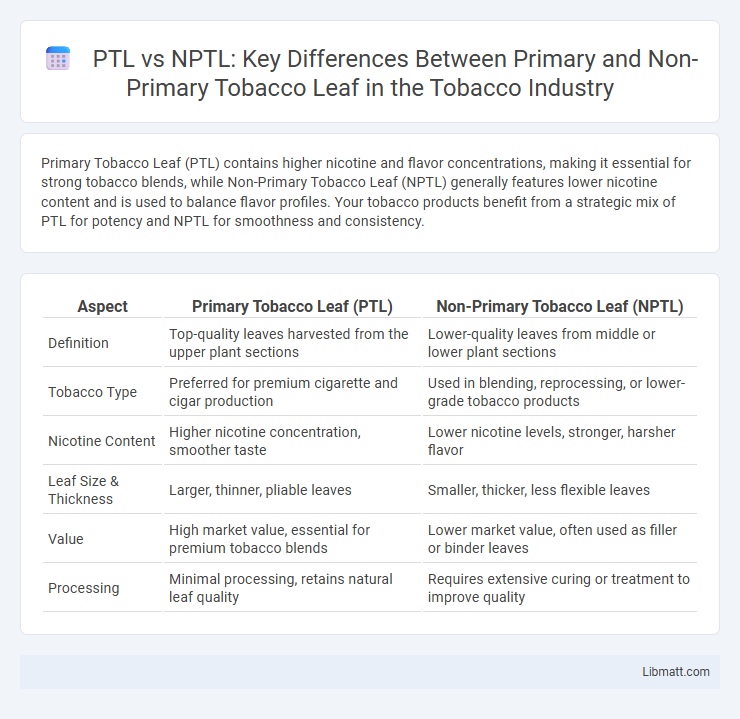Primary Tobacco Leaf (PTL) contains higher nicotine and flavor concentrations, making it essential for strong tobacco blends, while Non-Primary Tobacco Leaf (NPTL) generally features lower nicotine content and is used to balance flavor profiles. Your tobacco products benefit from a strategic mix of PTL for potency and NPTL for smoothness and consistency.
Table of Comparison
| Aspect | Primary Tobacco Leaf (PTL) | Non-Primary Tobacco Leaf (NPTL) |
|---|---|---|
| Definition | Top-quality leaves harvested from the upper plant sections | Lower-quality leaves from middle or lower plant sections |
| Tobacco Type | Preferred for premium cigarette and cigar production | Used in blending, reprocessing, or lower-grade tobacco products |
| Nicotine Content | Higher nicotine concentration, smoother taste | Lower nicotine levels, stronger, harsher flavor |
| Leaf Size & Thickness | Larger, thinner, pliable leaves | Smaller, thicker, less flexible leaves |
| Value | High market value, essential for premium tobacco blends | Lower market value, often used as filler or binder leaves |
| Processing | Minimal processing, retains natural leaf quality | Requires extensive curing or treatment to improve quality |
Understanding PTL and NPTL: Key Definitions
Primary Tobacco Leaf (PTL) refers to the main, high-quality leaves harvested from the upper sections of the tobacco plant, known for their superior texture and nicotine concentration. Non-Primary Tobacco Leaf (NPTL) consists of lower-quality leaves found on the lower parts of the plant, often used for blending or filler due to their coarser texture and lower nicotine levels. Understanding the distinctions between PTL and NPTL helps you optimize tobacco selection for desired flavor profiles and product quality in manufacturing.
Botanical Differences Between PTL and NPTL
Primary tobacco leaf (PTL) and non-primary tobacco leaf (NPTL) exhibit distinct botanical differences, primarily in leaf size, texture, and chemical composition. PTL leaves, harvested from the top of the tobacco plant, are larger, thinner, and contain higher nicotine concentrations, while NPTL leaves, growing lower on the stalk, tend to be smaller, thicker, and richer in sugars and essential oils. Your understanding of these botanical variations can enhance tobacco product selection and quality control processes.
Harvesting Processes for Primary vs Non-Primary Tobacco Leaf
Harvesting processes for Primary Tobacco Leaf (PTL) emphasize careful selection and handpicking to preserve leaf quality, as PTL is critical for premium tobacco products. In contrast, Non-Primary Tobacco Leaf (NPTL) harvesting involves more mechanized methods focusing on bulk collection for blending or filler use. Your choice between PTL and NPTL impacts the harvesting technique, influencing overall tobacco flavor and processing efficiency.
Chemical Composition: PTL vs NPTL
Primary Tobacco Leaf (PTL) typically contains higher nicotine levels and a richer concentration of key alkaloids compared to Non-Primary Tobacco Leaf (NPTL), affecting its potency and flavor profile. PTL shows a more consistent chemical composition with elevated sugars and essential oils, enhancing combustion and taste quality for tobacco products. Your product formulation benefits from selecting PTL when a stronger chemical impact with predictable results is desired.
Role of PTL and NPTL in Cigarette Manufacturing
Primary Tobacco Leaf (PTL) forms the core of cigarette manufacturing by providing the essential bulk and flavor profile critical to the smoking experience, influencing burn rate and taste consistency. Non-Primary Tobacco Leaf (NPTL) complements PTL by enhancing texture, moisture retention, and combustion characteristics, often used as filler to optimize cost without compromising cigarette quality. Your understanding of PTL and NPTL roles ensures better selection of raw materials for producing cigarettes with balanced flavor and performance.
Quality Assessment: PTL Compared to NPTL
Primary Tobacco Leaf (PTL) exhibits superior quality attributes compared to Non-Primary Tobacco Leaf (NPTL) due to its higher nicotine content, consistent leaf texture, and fewer defects. PTL undergoes more rigorous selection and curing processes, resulting in enhanced flavor profiles and combustibility, which are critical for premium tobacco products. Assessing Your tobacco inventory with a focus on PTL quality parameters ensures optimal product performance and consumer satisfaction.
Economic Implications: Value of PTL vs NPTL
Primary Tobacco Leaf (PTL) holds significantly higher economic value compared to Non-Primary Tobacco Leaf (NPTL) due to its superior quality and demand in cigarette manufacturing. PTL commands premium prices in domestic and international markets, directly impacting tobacco farmers' revenue and supply chain profitability. In contrast, NPTL, often used for tobacco blending or lower-grade products, generates lower economic returns and influences pricing structures within the tobacco industry.
Impact on Flavor and Aroma: PTL vs NPTL Analysis
Primary Tobacco Leaf (PTL) delivers a richer, more robust flavor and aroma due to its higher concentration of essential oils and natural sugars, enhancing the overall smoking experience. Non-Primary Tobacco Leaf (NPTL) tends to have a milder taste with fewer aromatic compounds, often used to balance or reduce the intensity in blends. Understanding the distinct flavor profiles of PTL and NPTL can help you optimize tobacco blends for a desired sensory outcome.
Regulatory Considerations for PTL and NPTL
Regulatory considerations for Primary Tobacco Leaf (PTL) emphasize strict compliance with agricultural standards, licensing requirements, and traceability to ensure product safety and quality control. Non-Primary Tobacco Leaf (NPTL) faces distinct regulations targeting its classification, usage restrictions, and often higher scrutiny due to its diverse origin and potential for adulteration. Both PTL and NPTL must adhere to regional and international regulations, including labeling, taxation, and environmental impact assessments, influencing their market distribution and legal status.
Future Trends in PTL and NPTL Utilization
Future trends in PTL (Primary Tobacco Leaf) focus on enhanced genetic breeding and sustainable cultivation techniques to improve yield quality and disease resistance. NPTL (Non-Primary Tobacco Leaf) utilization is expected to rise through innovative uses in bioenergy, pharmaceuticals, and alternative nicotine products, driven by increasing regulatory pressures on conventional tobacco use. Advances in biotechnology and supply chain optimization are likely to further integrate PTL and NPTL into diversified applications, fostering a more sustainable tobacco industry.
PTL vs NPTL (Primary tobacco leaf vs Non-primary tobacco leaf) Infographic

 libmatt.com
libmatt.com